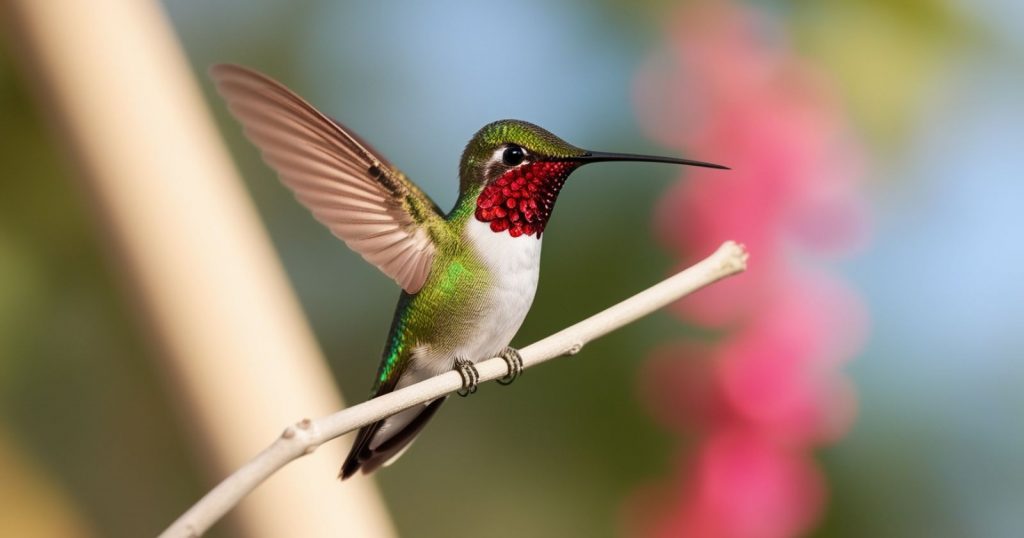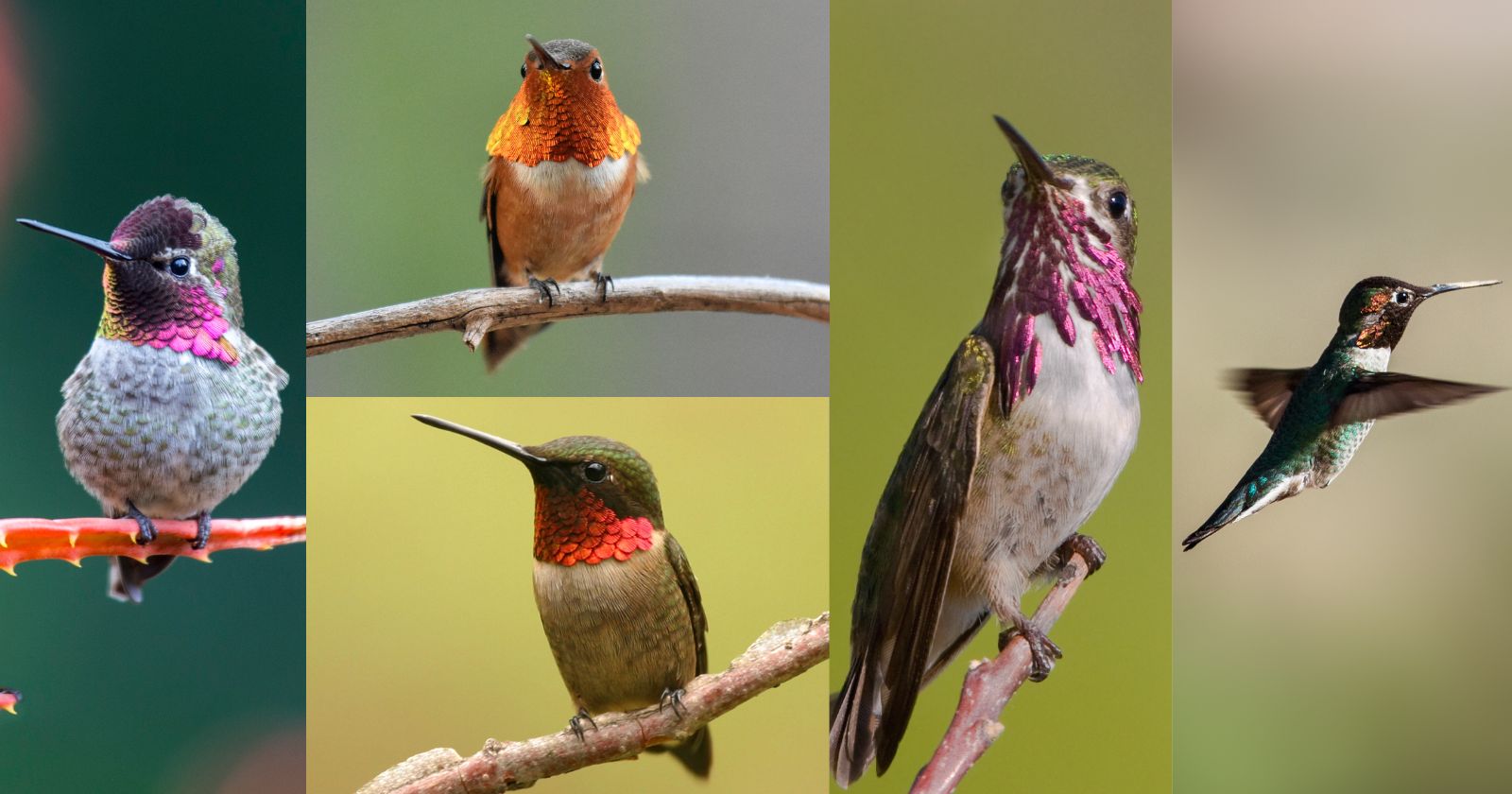Hummingbirds are amazing birds that impress us with their small size, bright colours, and fantastic flying skills. Although Canada might not be the first place you think of for these birds, several species come to the Great White North during the warmer months.
In this blog post, I’ll talk about the characteristics, habitats, and behaviours of these special birds. This guide will help you identify and enjoy Canada’s hummingbird visitors.
So, let’s get started and look at the 5 most common hummingbird species you’re likely to see in Canada.
Which Hummingbirds Are Most Frequently Seen in Canada?
The five hummingbird species most commonly observed in Canada are the Ruby-throated Hummingbird, Rufous Hummingbird, Anna’s Hummingbird, Black-chinned Hummingbird, and Calliope Hummingbird.
These species have adapted to the Canadian climate and ecosystems, typically arriving in spring and departing in autumn, with the exception of some Anna’s Hummingbirds that have begun overwintering in coastal British Columbia.
Related Post: Are There Hummingbirds In Canada?

1. Ruby-throated Hummingbird
The Ruby-throated Hummingbird (Archilochus colubris) is by far the most widespread hummingbird species in Canada. It’s the only hummingbird regularly found in eastern Canada, making it a familiar sight for many Canadians.
Key features:
- Length: 7-9 cm
- Wingspan: 8-11 cm
- Weight: 2-6 g.
Appearance:
- Males: Emerald green back, white underparts, and a distinctive ruby-red throat (gorget)
- Females: Similar colouration but lacking the red throat.
Range in Canada:
The Ruby-throated Hummingbird can be found across eastern Canada, from the Maritime provinces to eastern Manitoba. They are also spotted in parts of Saskatchewan and Alberta.
Behavior:
These tiny birds are known for their incredible flying skills, including the ability to hover and fly backward. They are often seen visiting gardens with tubular flowers and hummingbird feeders.

2. Rufous Hummingbird
The Rufous Hummingbird (Selasphorus rufus) is a feisty little bird that’s common in western Canada during the breeding season.
Key features:
- Length: 7-9 cm
- Wingspan: 11 cm
- Weight: 2-5 g.
Appearance:
- Males: Bright orange-red throat, rufous (reddish-brown) back and sides
- Females: Greenback, rufous sides, and white throat with some red spotting.
Range in Canada:
Primarily found in British Columbia and western Alberta, with some sightings in Yukon Territory.
Behavior:
Known for their aggressive nature, Rufous Hummingbirds often chase away larger birds from food sources. They have an impressive migration, travelling up to 3,900 miles from Mexico to Alaska.

3. Anna’s Hummingbird
Anna’s Hummingbird (Calypte anna) is unique among Canadian hummingbirds as some individuals have begun to overwinter in parts of coastal British Columbia.
Key features:
- Length: 9-10 cm
- Wingspan: 11-12 cm
- Weight: 3-6 g.
Appearance:
- Males: Greenback, grey underparts, and a distinctive iridescent rose-red crown and throat
- Females: Similar colouration but with a small red patch on the throat.
Range in Canada:
Primarily found in coastal and southern British Columbia.
Behavior:
Anna’s Hummingbirds are known for their elaborate courtship displays, where males climb up to 40 meters before diving steeply while making a loud chirp with their tail feathers.

4. Black-chinned Hummingbird
The Black-chinned Hummingbird (Archilochus alexandri) is less common in Canada but can be found in certain regions during the breeding season.
Key features:
- Length: 8-9 cm
- Wingspan: 11 cm
- Weight: 2-4 g.
Appearance:
- Males: Greenback, white underparts, and a black chin with a thin strip of iridescent purple at the base
- Females: Similar colouration but lacking the black chin and purple strip.
Range in Canada:
Found in southern British Columbia and occasionally in southern Alberta.
Behavior:
These adaptable birds are often found in urban areas and are known for their tolerance of heat, being able to withstand temperatures up to 40°C.

5. Calliope Hummingbird
The Calliope Hummingbird (Selasphorus calliope) is the smallest breeding bird in Canada and the United States.
Key features:
- Length: 7-8 cm
- Wingspan: 11 cm
- Weight: 2-3 g.
Appearance:
- Males: Greenback, white underparts, and a distinctive magenta starburst pattern on the throat
- Females: Similar colouration but lacking the magenta throat markings
Range in Canada:
Found in southern British Columbia and southwestern Alberta.
Behavior:
Despite their tiny size, Calliope Hummingbirds are known for their long-distance migrations, travelling up to 5,600 miles round trip between their breeding and wintering grounds.
The Role of Hummingbirds in Canadian Ecosystems
Hummingbirds play a crucial role in Canadian ecosystems as important pollinators. Their long beaks and ability to hover make them perfectly adapted for feeding on nectar from tubular flowers. As they move from flower to flower, they transfer pollen, helping in plant reproduction.
Conservation and Challenges
While hummingbirds are not currently considered threatened in Canada, they face various challenges:
- Habitat loss due to urbanization and agriculture
- Climate change affecting migration patterns and food availability
- Use of pesticides reducing insect populations (an important food source)
- Window collisions in urban areas.
Conservation efforts focus on preserving natural habitats and encouraging the creation of hummingbird-friendly gardens. Citizen science projects also play a crucial role in monitoring hummingbird populations and behaviours.
How to Attract Hummingbirds to Your Garden
If you’d like to attract these fascinating birds to your garden, consider the following tips:
- Plant native, nectar-rich flowers with tubular blossoms
- Provide a clean water source, such as a shallow birdbath or mister
- Hang hummingbird feeders filled with a solution of 1 part white sugar to 4 parts water
- Avoid using pesticides in your garden
- Create perching spots with small, bare branches.
Remember to clean feeders regularly and change the sugar solution every few days to prevent the growth of harmful bacteria.
Final Thoughts
The presence of hummingbirds in Canada shows the country’s diverse ecosystems and the incredible adaptability of these tiny birds. From the widespread Ruby-throated Hummingbird in the east to the feisty Rufous Hummingbird in the west, each species adds its own unique charm to the Canadian landscape.
As we continue to learn more about these fascinating birds, it’s clear that they play a vital role in our ecosystems and bring joy to many Canadians who eagerly await their arrival each spring.
Before we conclude, here’s a question for you: Have you ever spotted a hummingbird in your area, and if so, which species do you think it was? Share your experiences in the comments below – your observations could contribute valuable data to our understanding of hummingbird distributions in Canada.
Thank you for reading. If you found it helpful, please consider sharing it with fellow bird lovers who might be interested in attracting these delightful visitors to their gardens.
